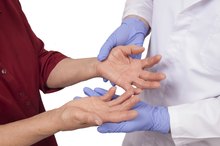Causes of Pain in the Buttock Area
Colloquialisms aside, pain in the buttock area is no laughing matter. From an anatomical perspective, this area is highly complex with several muscles, tendons and nerves in addition to the bones of the pelvis and hip joint, and other soft tissues. All of these structures can potentially trigger buttock pain that could interfere with your daily activities and fitness pursuits.
If you are experiencing serious medical symptoms, seek emergency treatment immediately.
Hip Arthritis
The hip is a leading site of osteoarthritis, or degenerative arthritis, which typically occurs due to age- or injury-related wear and tear. Buttock pain proves very common with hip osteoarthritis and is second only to groin pain, according to a study published in 2004 in the Annals of the Royal College of Surgeons of England 1. Osteoarthritis-related buttock pain characteristically develops gradually and manifests as achiness, which is typically accompanied by joint stiffness.
Herniated Lumbar Disc
Causes of Pain in the Hip and Groin Area
Learn More
A herniated disc in lumbar section of the spine -- located in the small of the back just above the buttocks -- can cause referred pain in the gluteal area.
**When a disc herniates, it might compress the nerve roots emerging from the spine at the affected level.
** Gluteal pain most often occurs with a disc herniation at the L4/5 level, meaning the disc between the fourth and fifth lumbar spine bones 2. The pain might radiate down the back of the thigh and be accompanied by low back pain.
- A herniated disc in lumbar section of the spine -- located in the small of the back just above the buttocks -- can cause referred pain in the gluteal area.
- When a disc herniates, it might compress the nerve roots emerging from the spine at the affected level.
Sacroiliac Joint Disorder
The sacroiliac joints, or SI joints, join the sacrum bone at the base of the spine to the hip bones.
SI joint disorders typically cause low back and upper buttock pain that might radiate down the back of the thigh. Sitting for long periods, bending forward and shifting body weight from one leg to the other -- such as when climbing stairs or using an elliptical trainer -- typically aggravate SI joint pain.
Several SI joint disorders can provoke buttock and low back pain, including traumatic injury, arthritis and ligament strain. Pregnancy increase the risk for SI joint pain due to hormone-related loosening of the joint ligaments.
- The sacroiliac joints, or SI joints, join the sacrum bone at the base of the spine to the hip bones.
- Several SI joint disorders can provoke buttock and low back pain, including traumatic injury, arthritis and ligament strain.
Muscle or Tendon Injury
Causes of Nerve Pain in the Hip & Leg
Learn More
**The buttock area contains 8 muscles -- the glutes and the deep gluteal muscles -- as well as the tendinous attachments of the hamstring muscles of the thigh.
** A strain injury involving any of these muscles or tendons can trigger buttock pain.
High hamstring tendon problems usually develop gradually and cause pain in the lower buttock area over the sit bone, or ischial tuberosity. Muscle strains occur more acutely. The specific location of the pain depends on the site of the strain injury.
- The buttock area contains 8 muscles -- the glutes and the deep gluteal muscles -- as well as the tendinous attachments of the hamstring muscles of the thigh.
- A strain injury involving any of these muscles or tendons can trigger buttock pain.
Hip Bursitis
The hip contains 4 bursae, fluid-filled sacs that cushion friction points. Bursitis refers to inflammation of one or more of these sacs. Inflammation of the gluteal or ischial bursa can cause pain in the buttock area. With gluteal bursitis, pain occurs in the upper outer buttock on the affected side. With ischial bursitis, pain occurs over the sit bone and might radiate down the back of the thigh.
- The hip contains 4 bursae, fluid-filled sacs that cushion friction points.
- With ischial bursitis, pain occurs over the sit bone and might radiate down the back of the thigh.
Coccydynia
Coccydynia refers to tailbone, or coccyx, pain 6. Tailbone pain and tenderness most frequently occurs due to traumatic injury, such as a backward fall. Coccyx pain can also occur after a vaginal delivery, particularly if the labor was long or difficult.
Other causes of coccydynia include prolonged sitting on hard surfaces, arthritis and abnormalities of the joint that joins the coccyx and sacrum. Tailbone pain is aggravated by sitting, standing up and possibly moving the bowels.
- Coccydynia refers to tailbone, or coccyx, pain 6.
- Coccyx pain can also occur after a vaginal delivery, particularly if the labor was long or difficult.
Deep Gluteal Syndrome
Deep gluteal syndrome is an uncommon condition that causes buttock pain due to compression of the sciatic nerve in the gluteal area before it enters the pelvis.
Sciatic nerve compression with deep gluteal syndrome can be caused by any of several structures, including the gluteal, upper hamstring or piriformis muscles, a blood vessel malformation or a tumor. In addition to buttock pain, symptoms might include numbness, burning or tingling in the gluteal area and possibly down the back of the thigh.
See your doctor if you experience buttock pain that seems unrelated to muscle soreness to determine the cause and best treatment options. Seek medical care right away if your buttock pain is related to a traumatic injury or is accompanied by difficulty walking or bearing weight, or leg weakness.
Related Articles
References
- Annals of the Royal College of Surgeons of England: Hip Osteoarthritis: Where is the Pain?
- BMC Musculoskeletal Disorders: Which Level Is Responsible for Gluteal Pain in Lumbar Disc Hernia?
- Sports Health: Posterior Hip Pain in an Athletic Population -- Differential Diagnosis and Treatment Options
- Sports-Health: Chronic High (Proximal) Hamstring Tendinopathy
- Atlas of Uncommon Pain Syndromes, 3rd Edition; Steven D. Waldman
- The Ochsner Journal: Coccydynia: An Overview of the Anatomy, Etiology, and Treatment of Coccyx Pain
- Journal of Hip Preservation Surgery: Deep Gluteal Syndrome
- American Family Physician: Evaluation of the Patient with Hip Pain
- Plante M, Wallace R, Busconi BD. Clinical diagnosis of hip pain. Clin Sports Med. 2011;30(2):225-38. doi:10.1016/j.csm.2010.12.003
- Wilson JJ, Furukawa M. Evaluation of the patient with hip pain. Am Fam Physician. 2014;89(1):27-34. PMID: 24444505
- Gold M, Varacallo M. Anatomy, Bony Pelvis and Lower Limb, Hip Joint. [Updated 2019 Apr 6]. In: StatPearls [Internet]. Treasure Island (FL): StatPearls Publishing; 2019 Jan-.
- Byrd JW. Evaluation of the hip: history and physical examination. N Am J Sports Phys Ther. 2007;2(4):231–240. PMID: 21509142
- Battaglia PJ, D'Angelo K, Kettner NW. Posterior, Lateral, and Anterior Hip Pain Due to Musculoskeletal Origin: A Narrative Literature Review of History, Physical Examination, and Diagnostic Imaging. J Chiropr Med. 2016;15(4):281–293. doi:10.1016/j.jcm.2016.08.004
- Hamer AJ. Pain in the hip and knee. BMJ. 2004;328(7447):1067–1069. doi:10.1136/bmj.328.7447.1067
- Lespasio MJ, Sultan AA, Piuzzi NS, et al. Hip Osteoarthritis: A Primer. Perm J. 2018;22:17–084. doi:10.7812/TPP/17-084
- Neogi T. The epidemiology and impact of pain in osteoarthritis. Osteoarthritis Cartilage. 2013;21(9):1145–1153. doi:10.1016/j.joca.2013.03.018
- Kim Y, Oh HC, Park JW, et al. Diagnosis and Treatment of Inflammatory Joint Disease. Hip Pelvis. 2017;29(4):211–222. doi:10.5371/hp.2017.29.4.211
- Bateman L, Vuppala S, Porada P, et al. Medical management in the acute hip fracture patient: a comprehensive review for the internist. Ochsner J. 2012;12(2):101–110. PMID: 22778674
- Nazem TG, Ackerman KE. The female athlete triad. Sports Health. 2012;4(4):302–311. doi:10.1177/1941738112439685
- Pisani P, Renna MD, Conversano F, et al. Major osteoporotic fragility fractures: Risk factor updates and societal impact. World J Orthop. 2016;7(3):171–181. Published 2016 Mar 18. doi:10.5312/wjo.v7.i3.171
- Williams CH, Sternard BT. Bursitis. [Updated 2019 Sep 11]. In: StatPearls [Internet]. Treasure Island (FL): StatPearls Publishing; 2019 Jan-.
- Tyler TF, Fukunaga T, Gellert J. Rehabilitation of soft tissue injuries of the hip and pelvis. Int J Sports Phys Ther. 2014;9(6):785–797. PMID: 25383247
- Reiman MP, Thorborg K. Clinical examination and physical assessment of hip joint-related pain in athletes. Int J Sports Phys Ther. 2014;9(6):737–755. PMID: 25383243
- Zapparoli FY, Riberto M. Isokinetic Evaluation of the Hip Flexor and Extensor Muscles: A Systematic Review. J Sport Rehabil. 2017;26(6):556-566. doi:10.1123/jsr.2016-0036
- Dallinga JM, Benjaminse A, Lemmink KA. Which screening tools can predict injury to the lower extremities in team sports?: a systematic review. Sports Med. 2012;42(9):791-815. doi:10.1007/bf03262295
- Tyler TF, Nicholas SJ. Rehabilitation of extra-articular sources of hip pain in athletes. N Am J Sports Phys Ther. 2007;2(4):207–216. PMID: 21509140
- Lespasio MJ, Sodhi N, Mont MA. Osteonecrosis of the Hip: A Primer. Perm J. 2019;23:18-100. doi:10.7812/TPP/18-100
- An YS, Park S, Jung JY, Suh CH, Kim HA. Clinical characteristics and role of whole-body bone scan in multifocal osteonecrosis. BMC Musculoskelet Disord. 2019;20(1):23. Published 2019 Jan 15. doi:10.1186/s12891-019-2401-y
- Nakamura J, Konno K, Orita S, et al. Distribution of hip pain in patients with idiopathic osteonecrosis of the femoral head. Mod Rheumatol. 2017;27(3):503-507. doi:10.1080/14397595.2016.1209830
- Groh MM, Herrera J. A comprehensive review of hip labral tears. Curr Rev Musculoskelet Med. 2009;2(2):105–117. doi:10.1007/s12178-009-9052-9
- Pun S, Kumar D, Lane NE. Femoroacetabular impingement. Arthritis Rheumatol. 2015;67(1):17–27. doi:10.1002/art.38887
- Zhang C, Li L, Forster BB, et al. Femoroacetabular impingement and osteoarthritis of the hip. Can Fam Physician. 2015;61(12):1055–1060. PMID: 26668284
- Long B, Koyfman A, Gottlieb M. Evaluation and Management of Septic Arthritis and its Mimics in the Emergency Department. West J Emerg Med. 2019;20(2):331–341. doi:10.5811/westjem.2018.10.40974
- Shirtliff ME, Mader JT. Acute septic arthritis. Clin Microbiol Rev. 2002;15(4):527–544. doi:10.1128/cmr.15.4.527-544.2002
- Mantyh PW. Bone cancer pain: from mechanism to therapy. Curr Opin Support Palliat Care. 2014;8(2):83–90. doi:10.1097/SPC.0000000000000048
- Lipton A, Uzzo R, Amato RJ, et al. The science and practice of bone health in oncology: managing bone loss and metastasis in patients with solid tumors. J Natl Compr Canc Netw. 2009;7 Suppl 7(Suppl 7):S1–S30. doi:10.6004/jnccn.2009.0080
- Grumet RC, Frank RM, Slabaugh MA, Virkus WW, Bush-Joseph CA, Nho SJ. Lateral hip pain in an athletic population: differential diagnosis and treatment options. Sports Health. 2010;2(3):191–196. doi:10.1177/1941738110366829
- Seidman AJ, Varacallo M. Trochanteric Bursitis. [Updated 2019 Mar 10]. In: StatPearls [Internet]. Treasure Island (FL): StatPearls Publishing; 2019 Jan-.
- Reid D. The management of greater trochanteric pain syndrome: A systematic literature review. J Orthop. 2016;13(1):15–28. Published 2016 Jan 22. doi:10.1016/j.jor.2015.12.006
- Musick SR, Varacallo M. Snapping Hip Syndrome. [Updated 2019 Apr 16]. In: StatPearls [Internet]. Treasure Island (FL): StatPearls Publishing; 2019 Jan-.
- Lavine R. Iliotibial band friction syndrome. Curr Rev Musculoskelet Med. 2010;3(1-4):18–22. Published 2010 Jul 20. doi:10.1007/s12178-010-9061-8
- Lewis CL. Extra-articular Snapping Hip: A Literature Review. Sports Health. 2010;2(3):186–190. doi:10.1177/1941738109357298
- Winston P, Awan R, Cassidy JD, Bleakney RK. Clinical examination and ultrasound of self-reported snapping hip syndrome in elite ballet dancers. Am J Sports Med. 2007;35(1):118-26. doi:10.1177/0363546506293703
- Frank RM, Slabaugh MA, Grumet RC, Virkus WW, Bush-Joseph CA, Nho SJ. Posterior hip pain in an athletic population: differential diagnosis and treatment options. Sports Health. 2010;2(3):237–246. doi:10.1177/1941738110366000
- Vleeming A, Schuenke MD, Masi AT, Carreiro JE, Danneels L, Willard FH. The sacroiliac joint: an overview of its anatomy, function and potential clinical implications. J Anat. 2012;221(6):537–567. doi:10.1111/j.1469-7580.2012.01564.x
- Moscote-Salazar LR, Alvis-Miranda HR, Joaquim AF, Amaya-Quintero J, Padilla-Zambrano HS, Agrawal A. Sacroiliac Pain: A Clinical Approach for the Neurosurgeon. J Neurosci Rural Pract. 2017;8(4):622–627. doi:10.4103/jnrp.jnrp_171_17.
- Martin HD, Reddy M, Gómez-Hoyos J. Deep gluteal syndrome. J Hip Preserv Surg. 2015;2(2):99–107. doi:10.1093/jhps/hnv029
- Wagner T. A rare cause of hip pain characterized by an inability to walk or bear weight. JAAPA. 2011;24(9):34, 36-7. doi:10.1097/01720610-201109000-00006
- Martin HD, Palmer IJ. History and physical examination of the hip: the basics. Curr Rev Musculoskelet Med. 2013;6(3):219–225. doi:10.1007/s12178-013-9175-x
- Wilson CH. The Musculoskeletal Examination. In: Walker HK, Hall WD, Hurst JW, editors. Clinical Methods: The History, Physical, and Laboratory Examinations. 3rd edition. Boston: Butterworths; 1990. Chapter 164.
- Poultsides LA, Bedi A, Kelly BT. An algorithmic approach to mechanical hip pain. HSS J. 2012;8(3):213–224. doi:10.1007/s11420-012-9304-x
- Fujita K, Kabata T, Kajino Y, et al. Quantitative analysis of the Trendelenburg test and invention of a modified method. J Orthop Sci. 2017;22(1):81-88. doi:10.1016/j.jos.2016.09.007
- Deleanu B, Prejbeanu R, Tsiridis E, et al. Occult fractures of the proximal femur: imaging diagnosis and management of 82 cases in a regional trauma center. World J Emerg Surg. 2015;10:55. Published 2015 Nov 18. doi:10.1186/s13017-015-0049-y
- Annabell L, Master V, Rhodes A, Moreira B, Coetzee C, Tran P. Hip pathology: the diagnostic accuracy of magnetic resonance imaging. J Orthop Surg Res. 2018;13(1):127. Published 2018 May 29. doi:10.1186/s13018-018-0832-z
- Henderson RE, Walker BF, Young KJ. The accuracy of diagnostic ultrasound imaging for musculoskeletal soft tissue pathology of the extremities: a comprehensive review of the literature. Chiropr Man Therap. 2015;23:31. Published 2015 Nov 5. doi:10.1186/s12998-015-0076-5
- Fritz JM, McDonald JR. Osteomyelitis: approach to diagnosis and treatment. Phys Sportsmed. 2008;36(1):nihpa116823. doi:10.3810/psm.2008.12.11
- Chung C, Stern PJ, Dufton J. Urolithiasis presenting as right flank pain: a case report. J Can Chiropr Assoc. 2013;57(1):69–75. PMID: 23483000
- Cheatham SW, Kolber MJ, Salamh PA. Meralgia paresthetica: a review of the literature. Int J Sports Phys Ther. 2013;8(6):883–893. PMID: 24377074
- Parisi TJ, Mandrekar J, Dyck PJ, Klein CJ. Meralgia paresthetica: relation to obesity, advanced age, and diabetes mellitus. Neurology. 2011;77(16):1538–1542. doi:10.1212/WNL.0b013e318233b356
- Son BC, Kim DR, Kim IS, Hong JT, Sung JH, Lee SW. Neurolysis for meralgia paresthetica. J Korean Neurosurg Soc. 2012;51(6):363–366. doi:10.3340/jkns.2012.51.6.363
- Kita K. Leriche syndrome (Aortoiliac occlusive disease). J Gen Fam Med. 2017;18(5):297–298. Published 2017 Apr 21. doi:10.1002/jgf2.63
- Smith RB III. Claudication. In: Walker HK, Hall WD, Hurst JW, editors. Clinical Methods: The History, Physical, and Laboratory Examinations. 3rd edition. Boston: Butterworths; 1990. Chapter 13.
- Tawa N, Rhoda A, Diener I. Accuracy of magnetic resonance imaging in detecting lumbo-sacral nerve root compromise: a systematic literature review. BMC Musculoskelet Disord. 2016;17(1):386. Published 2016 Sep 6. doi:10.1186/s12891-016-1236-z
- Towheed TE, Judd MJ, Hochberg MC, Wells G. Acetaminophen for osteoarthritis. Cochrane Database Syst Rev. 2003;(2):CD004257. doi:10.1002/14651858.CD004257
- Hsu JR, Mir H, Wally MK, Seymour RB; Orthopaedic Trauma Association Musculoskeletal Pain Task Force. Clinical Practice Guidelines for Pain Management in Acute Musculoskeletal Injury. J Orthop Trauma. 2019;33(5):e158–e182. doi:10.1097/BOT.0000000000001430
- Köhler BM, Günther J, Kaudewitz D, Lorenz HM. Current Therapeutic Options in the Treatment of Rheumatoid Arthritis. J Clin Med. 2019;8(7):938. Published 2019 Jun 28. doi:10.3390/jcm8070938
- Uusi-Rasi K, Patil R, Karinkanta S, Tokola K, Kannus P, Sievänen H. Exercise Training in Treatment and Rehabilitation of Hip Osteoarthritis: A 12-Week Pilot Trial. J Osteoporos. 2017;2017:3905492. doi:10.1155/2017/3905492
- Carpintero P, Caeiro JR, Carpintero R, Morales A, Silva S, Mesa M. Complications of hip fractures: A review. World J Orthop. 2014;5(4):402–411. Published 2014 Sep 18. doi:10.5312/wjo.v5.i4.402
- Brembo EA, Kapstad H, Eide T, Månsson L, Van Dulmen S, Eide H. Patient information and emotional needs across the hip osteoarthritis continuum: a qualitative study.BMC Health Serv Res. 2016;16:88. Published 2016 Mar 12. doi:10.1186/s12913-016-1342-5
- Ross JR, Larson CM, Bedi A. Indications for Hip Arthroscopy. Sports Health. 2017;9(5):402–413. doi:10.1177/1941738117712675
- Cibulka MT, White DM, Woehrle J, et al. Hip pain and mobility deficits--hip osteoarthritis: clinical practice guidelines linked to the international classification of functioning, disability, and health from the orthopaedic section of the American Physical Therapy Association. J Orthop Sports Phys Ther. 2009;39(4):A1–A25. doi:10.2519/jospt.2009.0301
- Higgs J, Derbyshire E, Styles K. Nutrition and osteoporosis prevention for the orthopaedic surgeon: A wholefoods approach. EFORT Open Rev. 2017;2(6):300–308. Published 2017 Jun 23. doi:10.1302/2058-5241.2.160079
- Sabharwal S, Kumar A. Methods for assessing leg length discrepancy. Clin Orthop Relat Res. 2008;466(12):2910–2922. doi:10.1007/s11999-008-0524-9
- Berry SD, Miller RR. Falls: epidemiology, pathophysiology, and relationship to fracture. Curr Osteoporos Rep. 2008;6(4):149–154. doi:10.1007/s11914-008-0026-4
- Hip pain: MedlinePlus Medical Encyclopedia. MedlinePlus. Published November 6, 2019.
Writer Bio
Dr. Tina M. St. John owns and operates a health communications and consulting firm. She is also an accomplished medical writer and editor, and was formerly a senior medical officer with the U.S. Centers for Disease Control and Prevention. St. John holds an M.D. from Emory University School of Medicine.








